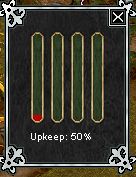Agriculture
Agriculture allows one to use the "Till Field" action under the Build menu. A tilled field is required to plant any seeds.
Farming:
Farming is accomplished by the general task of tilling a field, preparing it with Humus, and then planting seeds. After a period of time, your crops grow and you can then harvest them. Currently, the following seeds available for sale in Boston are Cabbage, Cereals, and Cotton. Pumpkin seeds can be obtained through Gardening. Once seeds are planted, you can then fertilize the fields using various items.
5 Humus are required to prepare a field for seeds.
Crop Growth and Rotation:
In this image, the 0th meter has about 5%. The other meters are empty.
The upkeep has been reduced to 50%, meaning 50% less humus and seed will be required to replant this field.
From Jorb (Brother Bean@Paradox/Beanieman@SynIRC.net#Salem):
"The crops use the following meters:
takes from -> gives to
Cabbage: 2,3 -> 0
Cereals: 3,0 -> 1
Cotton: 0,1 -> 2
Pumpkin: 1,2 -> 3
The idea here is obviously that you need to rotate your crops over your various fields, and fertilize them in an intelligent manner, in order to build up their meters and thus reach the higher output tiers. For example to reach higher tier of cereal you would need to build up meters it takes from 3 and 0, so you might rotate cabbage and cotton beforehand."
Crops will produce new types as the influence gets high enough.
- Cabbage: Colewort, Green Cabbage, White Cabbage and Red Cabbage
- Cereal: Oats, Rye, Barley, Wheat
- Cotton: Yellow-Stained Cotton, Indian Cotton, Egyptian Cotton and Sea Island Cotton
- Pumpkins: Pumpkins are a special case. They can be harvested at several points before the final growth stage for different item types. Some of them count as Inspirationals.
Pumpkins:
Here's the list of special cases for pumpkins:
Game Development: 12 varieties of Pumpkin
Postby jorb » Tue Jan 31, 2012 4:14 am
New world gourds can now be planted in gardening pots.
New world gourds are harvested as either (determined randomly).
"Baby Bear", "Red Bell Peppers" or "Green Bell Peppers".
"Baby Bear" can be sliced for pumpkin seeds. Pumpkin seeds can be planted in fields.
Pumpkins can be harvested in any one of the last three growth stages. The tier of the output is determined by the normal influence mechanics, but are also dependent on the growth stage.
Growth stage one: "Baby Bear", "Small Sugar", "Sugar Treat" and "Spooktacular" Growth stage two: "Autumn Gold", "Bushkin", "Harvest Moon" and "Jack-o-Lantern" Growth stage three: "Aspen", "Big Autumn", "Connecticut Field" and "Ghost Rider"
Spooktacular, Jack-o-Lantern and Ghost Rider are curios. All pumpkins can be sliced for generic pumpkin flesh and seeds.
All pumpkins in growth stage one can be replanted in gardening pots.
Fertilizers & Field Values:
Several items can be used as fertilizers and different fertilizers have different effects on your fields.
- Hay: Increases the influence the crop has on the field
- Wood Chopping: Decreases the upkeep needed on fields
- Lime: Increases plenty
- Humus: Increases influence and plenty
- Coal: Increases growth speed.
- Clay: Improves influence, penalizes growth speed
- Dross: Improves speed, penalizes plenty
Influence: This increases the amount that crop adds to the positive growth meter. Plenty: Increases field output Upkeep: Reduces the number of seeds needed to replant the field. Speed: Improved crop growing time.
Each value has a specific effect on the field:
- Upkeep: This reduces the amount of Humus needed to prepare a field as well as reduces the amount of seeds needed to replant the field. This value caps at 50%
- Plenty: This value increases the yield of a field when harvested. Currently, planting a field provides a random amount plenty from 0% to a percentage equal to the planter's Stocks & Cultivars/100.
- Speed: This value reduces the growth time of the field. Currently, the field advances one stage every 24 hours and may be harvested after four days after planting.
- Influence: This value increases the amount of gain of the four output meters.
After a field is harvested, all fertilizers are reset and each field loses 10% upkeep. For example, if I keep my field at 50% upkeep each time I plant them, when I replant, they will then lose upkeep value and then be at 55% upkeep.
Finally, the more fertilizers used on a field, the less effective the next one becomes. Each fertilizer counts as one, so a Wood Chopping, a Coal, a Humus, and a Clay counts as four fertilizers, which would be the same reduction as using four Humus. (Note: the exact calculation isn't know
Notes:
I'd like to improve this with screen shots and actual examples. This is going to be one area that may be a challenge.
